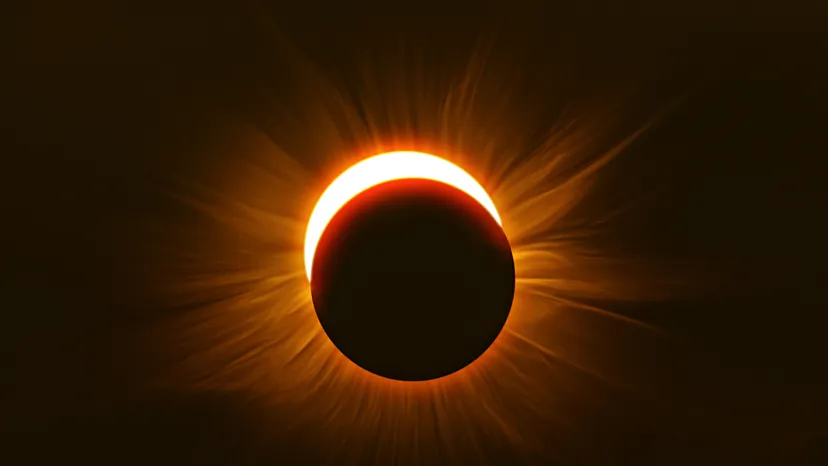A rare total solar eclipse 2024 on April 8 will produce a “path of totality” over North America, resulting in midday darkness over large portions of the US, Canada, and Mexico.
When the moon moves in front of the sun and obscures our vision of it, this is known as a solar eclipse. A total solar eclipse occurs when the moon shuts out the sun’s light. These are uncommon occurrences that are only seen for brief periods in particular locations.
The 2024 total solar eclipse path of totality will arc from Texas to the East Coast. If the weather is clear, cities like the town of Burl Vermont; Dallas, Texas; and Buffalo, New York, will have some of the best views.
What is a Solar Eclipse?
When the Moon moves in front of the Earth and the Sun, it can completely or partially obscure the Sun’s light, a process known as a solar eclipse.
An area of the moon that obscures the sun creates a shadow on Earth known as a “path of totality.” This path traverses the surface as a rather thin band. If the clouds and weather align, anybody standing inside this ring can see a total solar eclipse. The sky will grow gloomy, resembling dawn or dusk, when the Moon fully obscures the Sun in the line of totality.
People will only witness a partial eclipse if they are not on that line, or the path of totality. Depending on the extent to which the Moon obscures the Sun in their location, the sky will appear significantly darker to them than it did before the eclipse.

Total Eclipse 2024
when is the solar eclipse: April 8 is when the 2024 total solar eclipse will take place. A 185-kilometer span between Mexico, the US, and Canada will be visible for the totality, or complete darkening of the sky. It will also be viewed in up to eighteen different US states. However, skywatchers in India won’t be able to see it.,
The complete solar eclipse is scheduled to start at 9:12 p.m. Indian Standard Time (IST) on April 8, reach totality at 10:08 p.m., and conclude at 2:22 a.m. on April 9, 2024. Totality is expected to strike the Pacific coast of Mexico first, at approximately 11:07 am PDT, and exit Maine at approximately 1:30 pm PDT.
What is the average amount of total solar eclipses?
It is rare to witness a total solar eclipse glasses, and even more so when it is not visible from the United States.
The occurrences take place globally every one to three years, however they are frequently only visible from the poles or the center of the ocean.
Savoring a total solar eclipse involves several considerations. To ensure that the event isn’t obscured by clouds, viewers must have clear skies. Only those who are in the path of totality will witness the entire effect of the sun being blotted out. According to NASA, those who are not in the path of totality can still witness a partial eclipse, in which part of the sun is obscured by the moon.
Solar eclipse 2024 interactive map

| City | Percent of totality | Eclipse begins | Maximum eclipse | Eclipse ends |
|---|---|---|---|---|
| Luna Pier | 100% | 1:57 p.m. | 3:13 p.m. (Total eclipse lasts 19 seconds) | 4:26 p.m. |
| Monroe | 99.9% | 1:57 p.m. | 3:13 p.m. | 4:27 p.m. |
| Detroit | 99.2% | 1:58 p.m. | 3:14 p.m. | 4:27 p.m. |
| Livonia | 98.9% | 1:58 p.m. | 3:13 p.m. | 4:27 p.m. |
| Ann Arbor | 98.7% | 1:57 p.m. | 3:13 p.m. | 4:26 p.m. |
| Port Huron | 98.4% | 2:00 p.m. | 3:15 p.m. | 4:28 p.m. |
| Lansing | 96.2% | 1:56 p.m. | 3:12 p.m. | 4:25 p.m. |
| Grand Rapids | 93.7% | 1:55 p.m. | 3:11 p.m. | 4:24 p.m. |
| Alpena | 90% | 2:01 p.m. | 3:15 p.m. | 4:27 p.m. |
| Traverse City | 87.7% | 1:58 p.m. | 3:12 p.m. | 4:24 p.m. |
Even at 99% coverage, there is still enough sunlight to hurt your eyes during an eclipse. So you’ll want to make sure you have eclipse glasses or another form of eye safety
The last complete solar eclipse occurred when?
The last total solar eclipse glasses, which could only be seen from Antarctica, occurred in 2021. As per NOAA, the duration of totality was a mere minute and fifty-four seconds.
2017 saw the last total solar eclipse that North Americans could see. There were reports of the unusual occurrence in states ranging from South Carolina to Oregon. Before then, just five states were in the path of totality during the last total solar eclipse that could be seen in the United States since 1979.

What to know if your solar eclipse glasses are safe if they are “ISO certified”
When is the next solar eclipse that is total?
According to NOAA, the next total solar eclipse will occur on August 12, 2026. Views of this eclipse will be possible from Iceland, northern Spain, eastern Greenland, and the Arctic.
In the United States, observers of a total solar eclipse will have to wait a lot longer. The contiguous United States won’t see a total solar eclipse until August 2044.
FAQ’s
what time is the solar eclipse 2024?
The total solar eclipse will begin at 9:12 pm on April 8, totality will start at 10:08 pm, and will end on April 9, 2024, at 2:22 am.
when was the last solar eclipse?
August 21, 2017.
what time is the eclipse tomorrow?
The solar eclipse will begin at 9:12 pm on April 8.
What happens during lunar eclipse?
Earth’s shadow falls upon the surface of the Moon, dimming it and sometimes turning the lunar surface a striking red over a few hours.
Where to get eclipse glasses?
Get a free pair at Warby Parker or your local library, or buy a pair at these select retailers.
What is solar eclipse time?
9:12 pm on April 8, totality will start at 10:08 pm and will end on April 9, 2024, at 2:22 am.
How long will the eclipse last?
About two and a half hours.















Reader Interactions